SMR-Based Adaptive Mobility Management Scheme in Hierarchical SIP Networks
Abstract
:1. Introduction
2. Adaptive Mobility Management Scheme in HSIP
2.1. HSIP Scheme
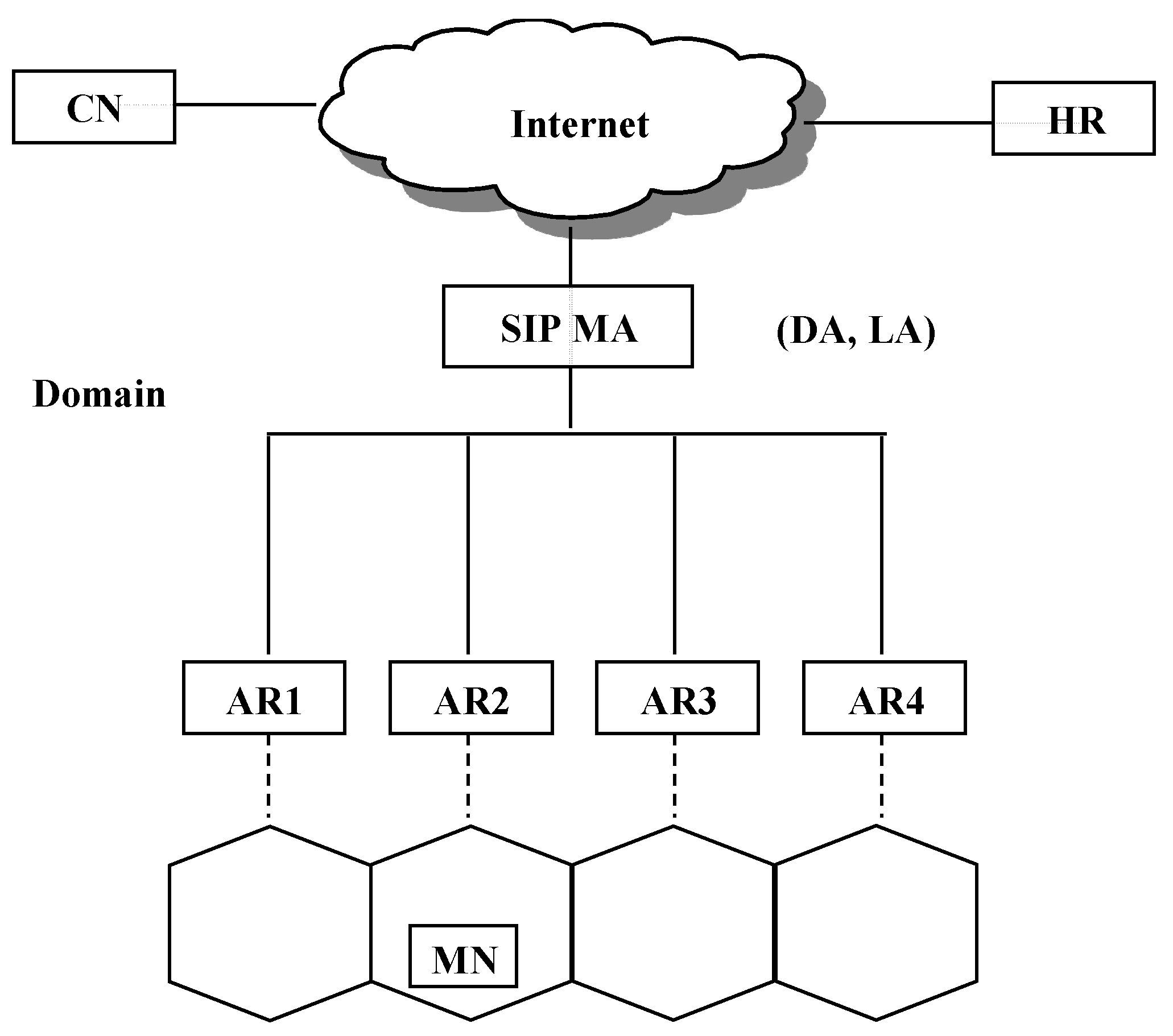
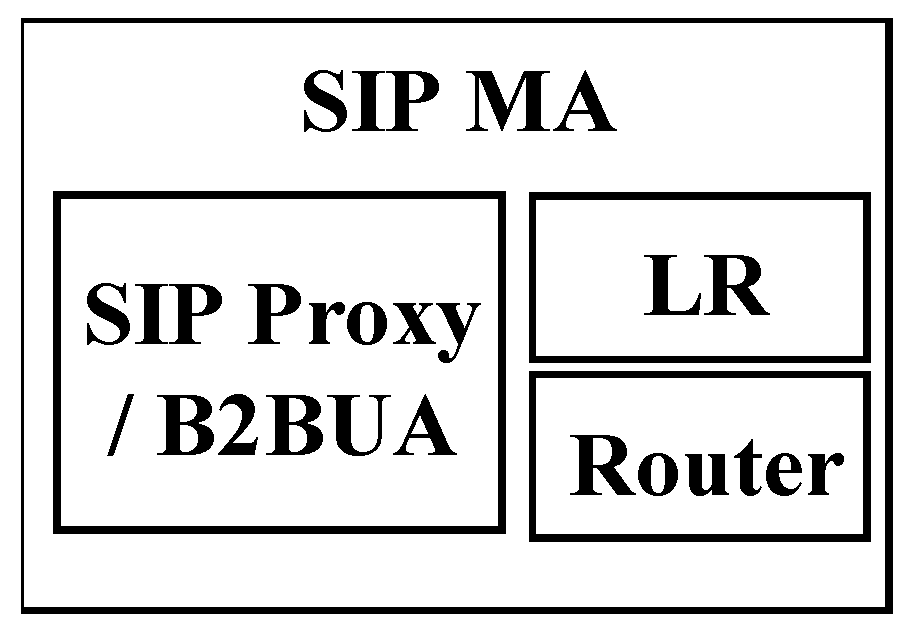
2.2. PHSIP Scheme
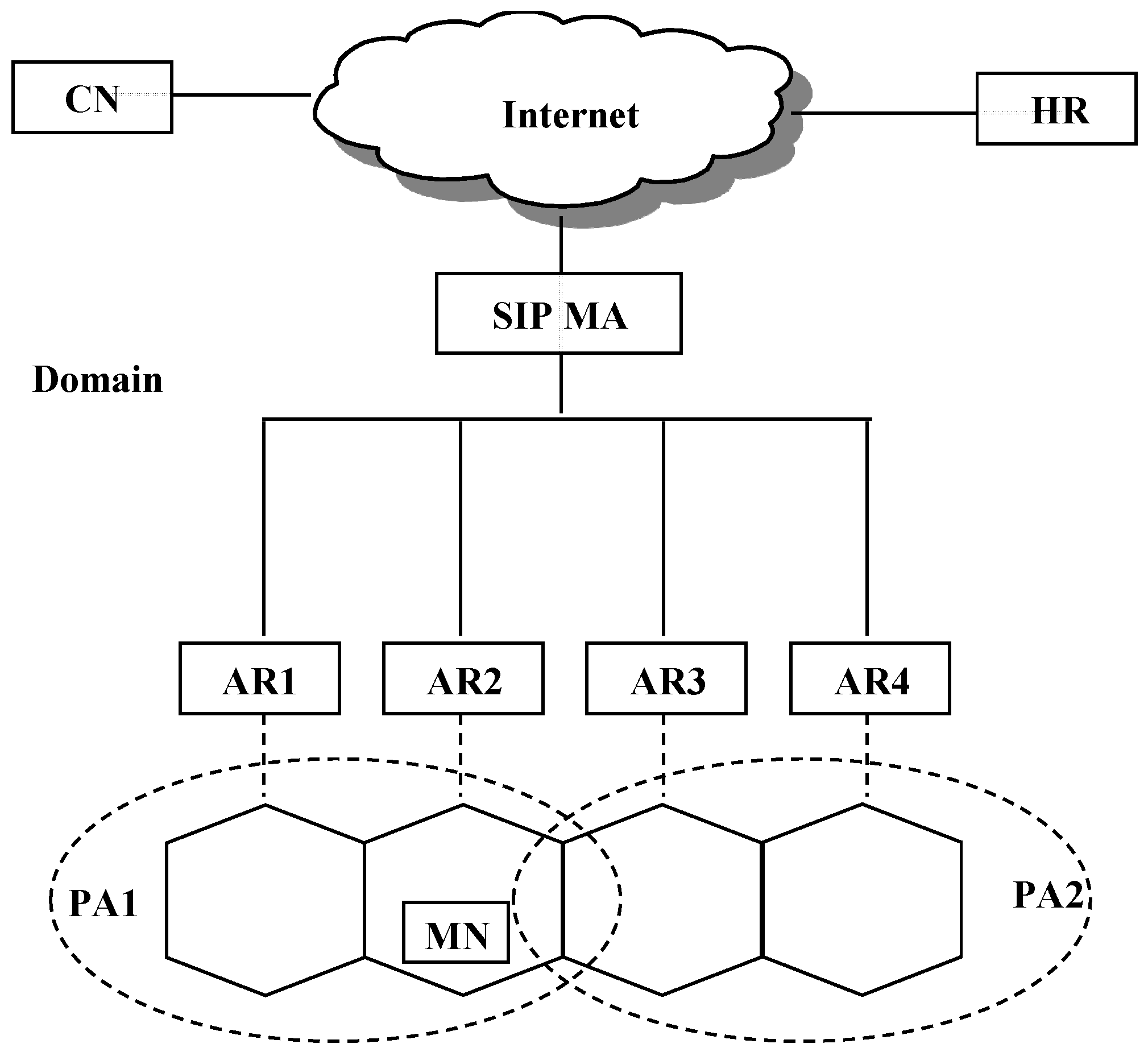
2.3. AHSIP Scheme


- An idle MN crosses the border of PA (inter-PA movement).
- An idle MN’s SMR is greater than the threshold value in a new cell.
- An MN leaves a TPA.

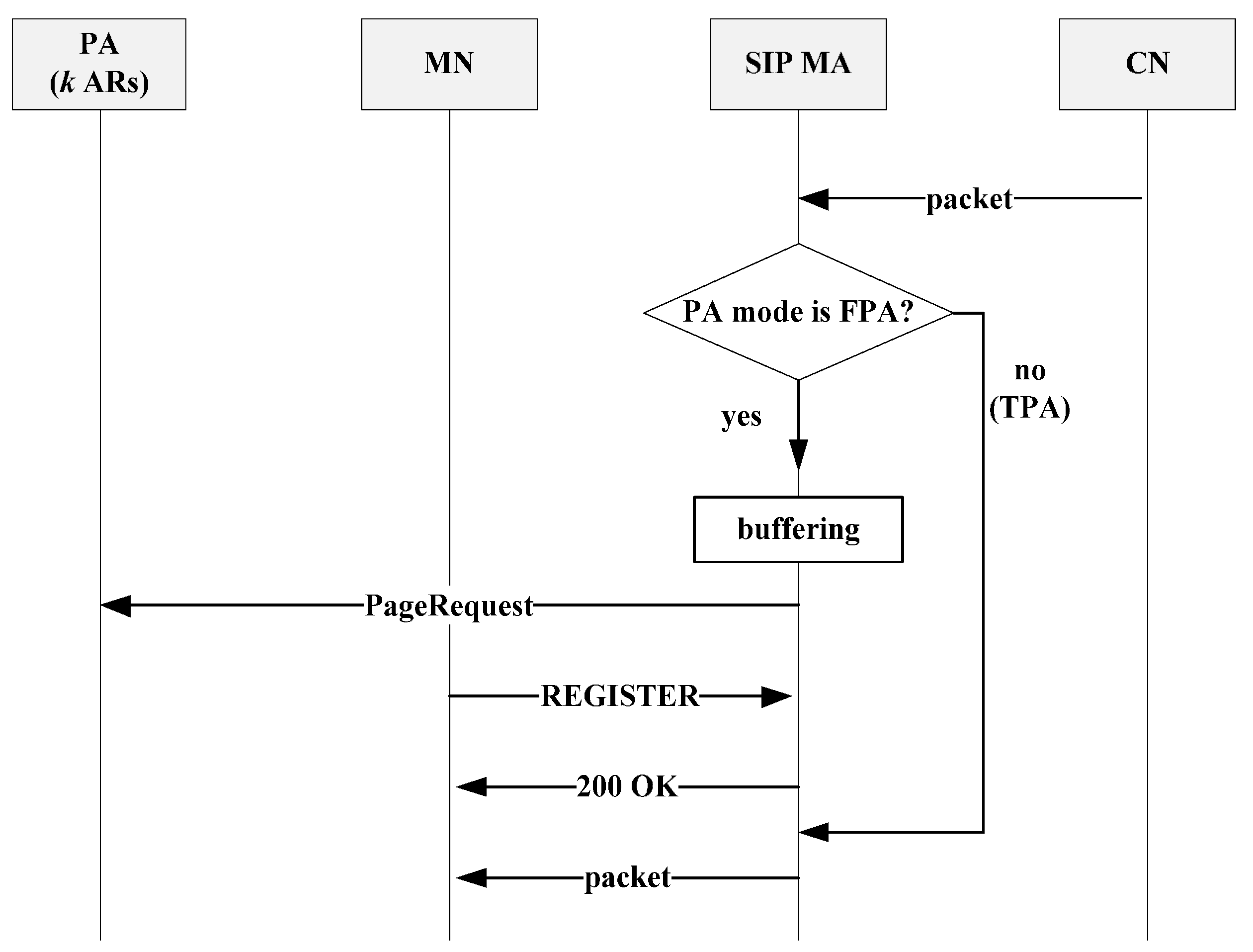
3. Performance Analysis
| Parameter | Definition |
|---|---|
| λs | Incoming session arrivals per unit time of the MN |
| λm | Inter-cell movements per unit time of the MN |
| lHM | Network transmission cost between the HR and the SIP MA |
| lMN | Network transmission cost between the SIP MA and the MN |
| αHR | DB processing cost for location update procedure at the HR |
| αMA | DB processing cost for location update procedure at the SIP MA |
| βHR | DB processing cost for packet delivery procedure at the HR |
| βMA | DB processing cost for packet delivery procedure at the SIP MA |
| N | The total number of cells |
| n | The total number of cells within a domain |
| k | The total number of cells within a PA (FPA) |
| m | The number of times that the MN changes its point of attachment |
| M | The random variable before each MN moves out of a domain at movement m |
| M' | The random variable before each MN moves out of a PA (FPA) at movement m |
| δ | Threshold to determine a TPA |
3.1. Cost in the HSIP Scheme
3.2. Cost in the PHSIP Scheme
3.3. Cost in the AHSIP Scheme
4. Numerical Results
| Parameter | Value | Parameter | Value |
|---|---|---|---|
| lHM | 4 | lMN | 2 |
| αHR | 12 | αMA | 6 |
| βHR | 12 | βMA | 6 |
| N | 100 | n | 25 |
| k | 5 | SMR | 0.001~10 |
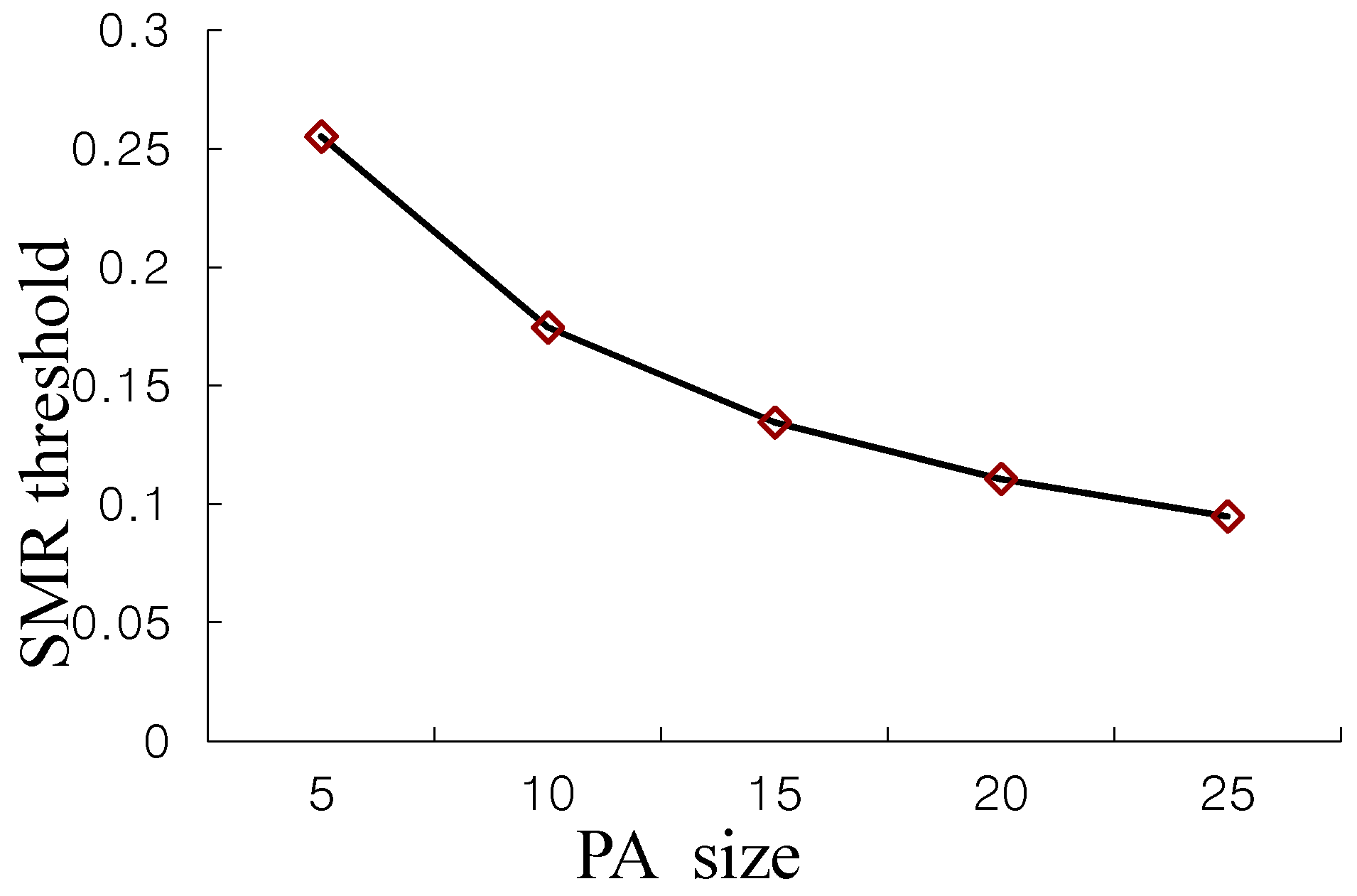
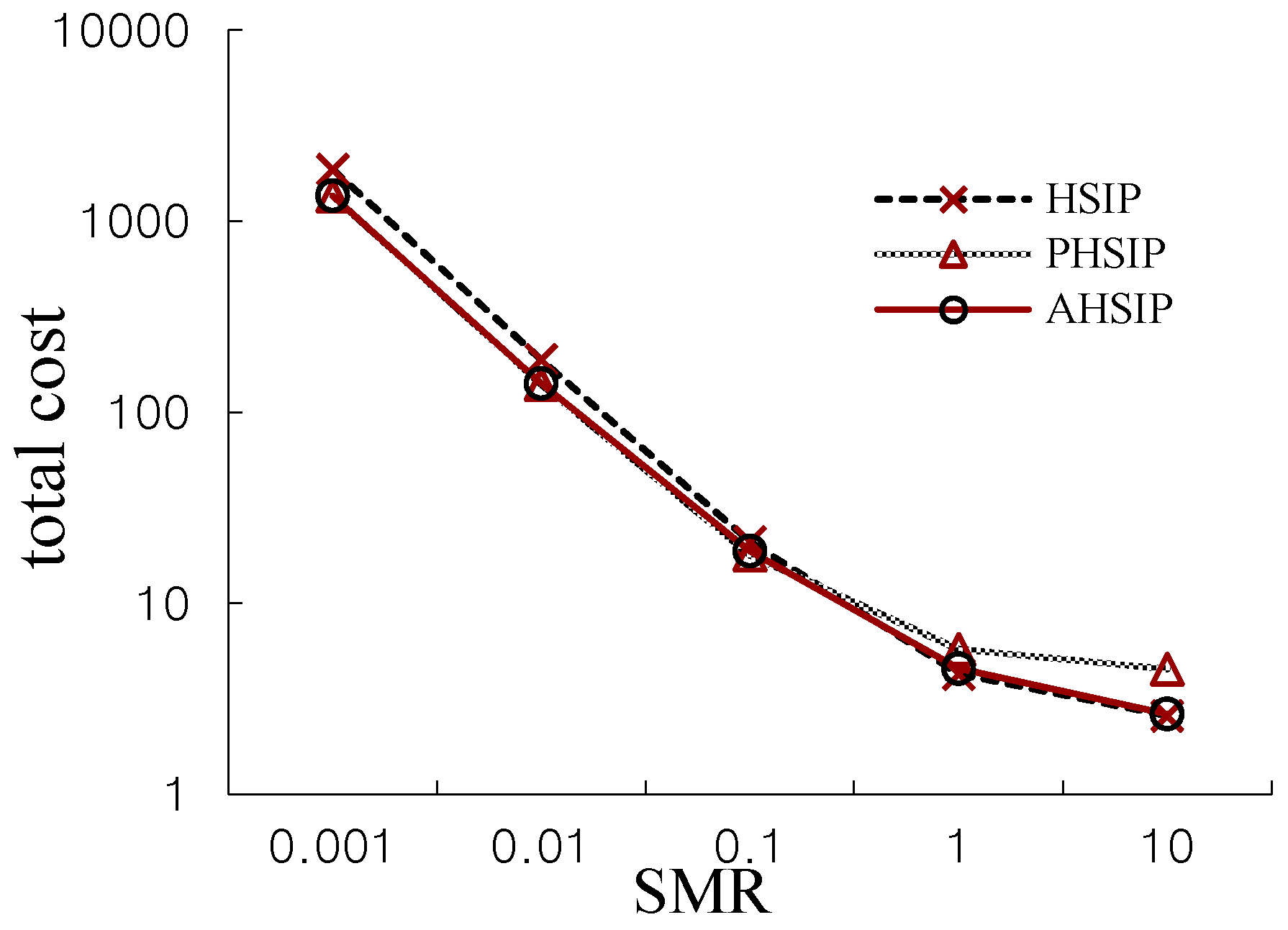
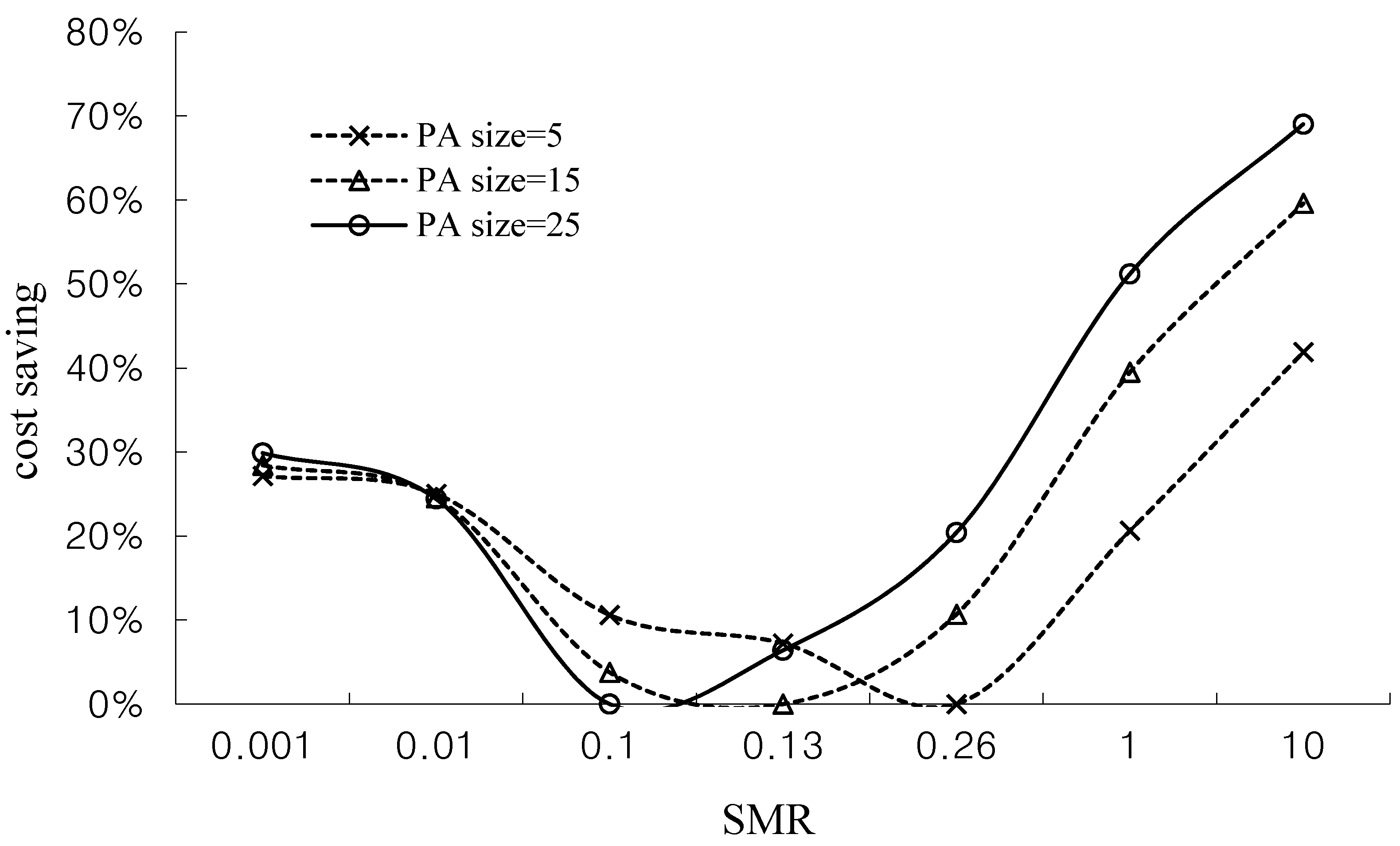
5. Conclusions
Acknowledgments
Author Contributions
Conflicts of Interest
References
- Perkins, C. IP Mobility Support for IPv4. Available online: https://tools.ietf.org/html/rfc3344 (accessed on 13 October 2014).
- Rosenberg, J.; Schulzrinne, H.; Camarillo, G.; Johnston, A.; Peterson, J.; Sparks, R.; Handley, M.; Schooler, E. SIP: Session Initiation Protocol. Available online: http://www.hjp.at/doc/rfc/rfc3261.html (accessed on 13 October 2014).
- Al-Surmi, I.; Othman, M.; Mohd, A.B. Mobility management for IP-based next generation mobile networks: Review, challenge and perspective. J. Netw. Comput. Appl. 2012, 35, 295–315. [Google Scholar] [CrossRef]
- Sharma, M.J.; Leung, V.C.M. IP Multimedia subsystem authentication protocol in LTE-heterogeneous networks. Hum. Cent. Comput. Inf. Sci. 2012, 2, 1–19. [Google Scholar] [CrossRef]
- El-Mohsen, O.; Saleh, H.A.M.; Elramly, S. SIP-Based Handoff Scheme in Next Generation Wireless Networks. In Proceedings of 6th International Conference on Next Generation Mobile Applications, Services and Technologies (NGMAST), Paris, France, 12–14 September 2012; pp. 131–136.
- Cheng, Y.-H.; Chang, F.-M.; Kao, S.-J. Efficient hierarchical SIP mobility management for WiMAX networks. Comput. Math. Appl. 2012, 64, 1522–1531. [Google Scholar] [CrossRef]
- Choi, K.H.; Kim, W.M.; Kim, J.K.; Kim, K.S. Design and implementation of IMS service continuity between IPTV and mobile. In Proceedings of 13th International Conference on Advanced Communication Technology (ICACT), Seoul, Korea, 13–16 February 2011; pp. 977–980.
- Javed, K.; Hussain, K.; Saleem, U.; Sher, M. An enhanced technique for vertical handover of multimedia traffic between WLAN and EVDO. J. Converg. 2010, 1, 107–112. [Google Scholar]
- Vali, D.; Paskalis, S.; Kaloxylos, A.; Merakos, L. A SIP-based method for intra-domain handoffs. In Proceedings of IEEE 58th Vehicular Technology Conference (VTC), Orlando, FL, USA, 6–9 October 2003; pp. 2068–2072.
- Vali, D.; Paskalis, S.; Kaloxylos, A.; Merakos, L. An efficient micro-mobility solution for SIP networks. In Proceedings of Global Telecommunications Conference (GLOBECOM), San Francisco, CA, USA, 1–5 December 2003; pp. 3088–3092.
- Misra, A.; Das, S.; Dutta, A.; McAuley, A.; Das, S.K. IDMP-based fast handoffs and paging in IP-based 4G mobile networks. IEEE Commun. Mag. 2002, 40, 138–145. [Google Scholar] [CrossRef]
- Zhang, X.; Castellanos, J.G.; Campbell, A.T. P-MIP: Paging extensions for mobile IP. Mob. Netw. Appl. 2002, 7, 127–141. [Google Scholar] [CrossRef]
- Yi, M.-K.; Hwang, C.-S. A Novel IP Paging Protocol for Minimizing Paging and Delay Costs in Hierarchical Mobile IPv6 Networks. IEICE Trans. Inf. Syst. 2004, 87, 2558–2568. [Google Scholar]
- Soliman, H.; Bellier, L.; Malki, K.E. Hierarchical mobile IPv6 (HMIPv6) mobility management. Available online: http://tools.ietf.org/html/rfc5380 (accessed on 13 October 2014).
- Fogelstroem, E.; Jonsson, A.; Perkins, C. Mobile IPv4 regional registration. Available online: http://tools.ietf.org/html/rfc4857 (accessed on 13 October 2014).
- Park, J.; Joe, I. Dynamic IP Paging Algorithm Based on the Velocity of Mobile Node for Proxy Mobile IPv6. Int. J. Multimed. Ubiquitous Eng. 2013, 8, 241–250. [Google Scholar] [CrossRef]
- Choi, H.Y.; Min, S.G.; Han, Y.H.; Koodli, R. Design and Simulation of a Flow Mobility Scheme Based on Proxy Mobile IPv6. J. Inf. Process. Syst. 2012, 8, 603–620. [Google Scholar] [CrossRef]
- Pack, S.; Kwon, T.; Choi, Y. A mobility-based load control scheme at mobility anchor point in hierarchical mobile IPv6 networks. In Proceedings of Global Telecommunications Conference (GLOBECOM), Dallas, TX, USA, 29 November–3 December 2004; pp. 3431–3435.
© 2014 by the authors; licensee MDPI, Basel, Switzerland. This article is an open access article distributed under the terms and conditions of the Creative Commons Attribution license (http://creativecommons.org/licenses/by/4.0/).
Share and Cite
Choi, K.; Gil, J.-M. SMR-Based Adaptive Mobility Management Scheme in Hierarchical SIP Networks. Information 2014, 5, 535-547. https://doi.org/10.3390/info5040535
Choi K, Gil J-M. SMR-Based Adaptive Mobility Management Scheme in Hierarchical SIP Networks. Information. 2014; 5(4):535-547. https://doi.org/10.3390/info5040535
Chicago/Turabian StyleChoi, KwangHee, and Joon-Min Gil. 2014. "SMR-Based Adaptive Mobility Management Scheme in Hierarchical SIP Networks" Information 5, no. 4: 535-547. https://doi.org/10.3390/info5040535





